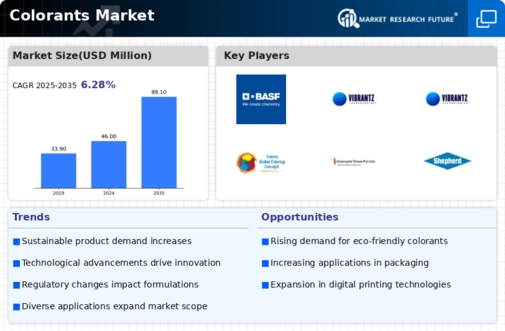Market Analysis
In-depth Analysis of Colorants Market Industry Landscape
The colorants market is a dynamic sector driven by a multitude of factors that influence supply, demand, and pricing. Market dynamics in the colorants industry are shaped by various elements including technological advancements, changing consumer preferences, regulatory frameworks, and macroeconomic trends. One of the primary drivers of this market is the ever-evolving consumer demand for vibrant and visually appealing products across multiple industries such as textiles, plastics, paints and coatings, and printing inks.
Technological innovations play a crucial role in shaping market dynamics within the colorants industry. Advances in colorant formulation and production processes continually push the boundaries of color accuracy, stability, and application versatility. Manufacturers invest heavily in research and development to create novel colorant solutions that meet the evolving needs of their customers. Moreover, the emergence of eco-friendly and sustainable colorants in response to growing environmental concerns has been a significant trend, driving market dynamics towards more environmentally responsible products.
Changing consumer preferences and trends heavily influence the colorants market, particularly in industries such as fashion, home décor, and automotive coatings. Color trends can shift rapidly, impacting demand for specific pigments and dyes. Companies in the colorants sector must stay attuned to these shifts and adapt their product offerings accordingly to remain competitive. Additionally, customization and personalization have become increasingly important in consumer goods, leading to a rise in demand for tailor-made color solutions.
Regulatory factors also significantly shape market dynamics in the colorants industry. Stringent regulations regarding the use of certain chemicals in colorant formulations, such as heavy metals or harmful organic compounds, drive manufacturers to develop safer alternatives. Compliance with international standards and regulations becomes a key consideration for companies operating in this market, influencing their product development strategies and market positioning.
Macroeconomic trends, including economic growth, industrial production, and currency fluctuations, have a profound impact on the colorants market. Economic downturns can lead to reduced consumer spending and industrial activity, affecting demand for colorants across various sectors. Conversely, periods of economic expansion typically correlate with increased demand for colorants as industries ramp up production to meet growing consumer demand.
Globalization has also transformed the dynamics of the colorants market, facilitating the exchange of products, technologies, and ideas across borders. Companies in this industry must navigate complex supply chains and global competition while capitalizing on opportunities in emerging markets with growing demand for colorant products.
Furthermore, mergers, acquisitions, and strategic partnerships are common strategies employed by companies in the colorants market to expand their market share, access new technologies, and diversify their product portfolios. Consolidation within the industry can influence market dynamics by altering the competitive landscape and reshaping pricing strategies.










Leave a Comment